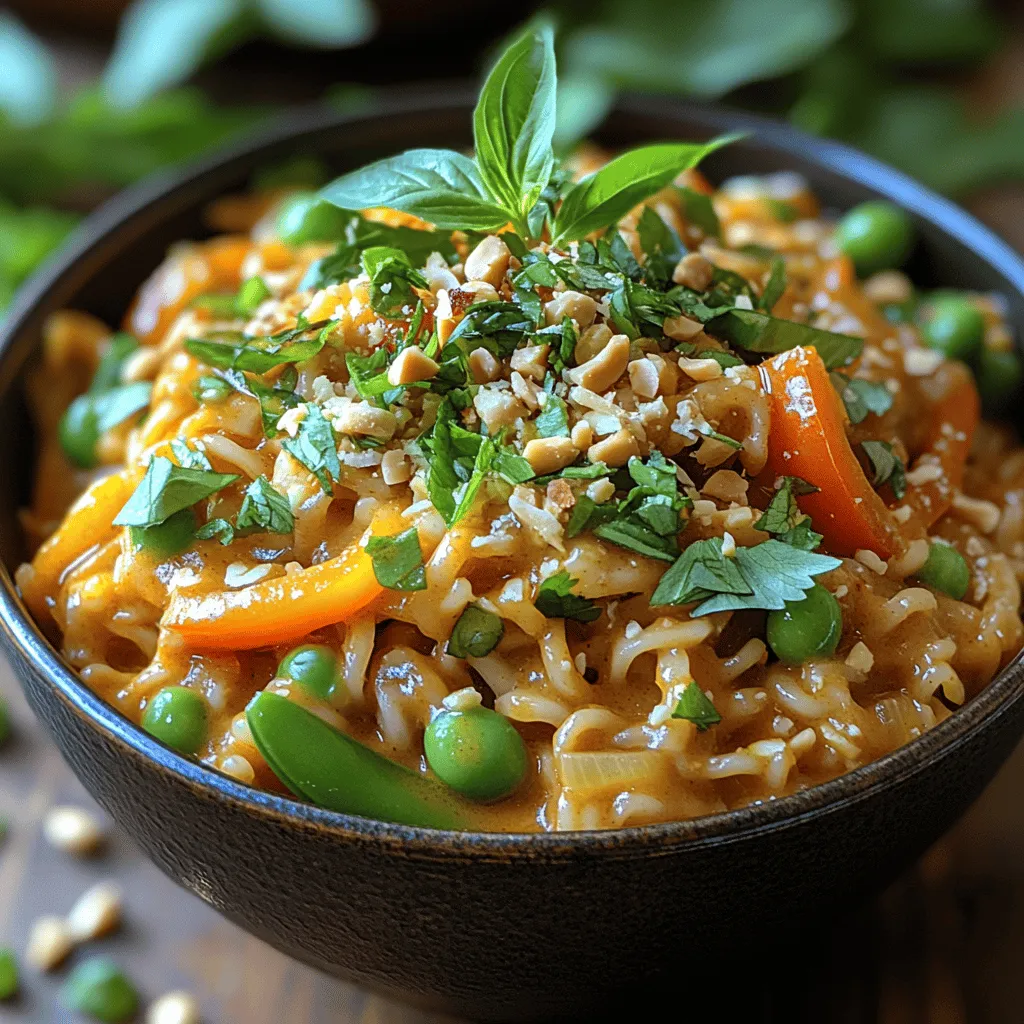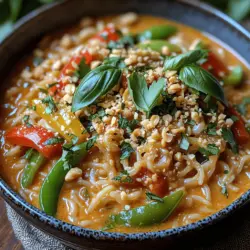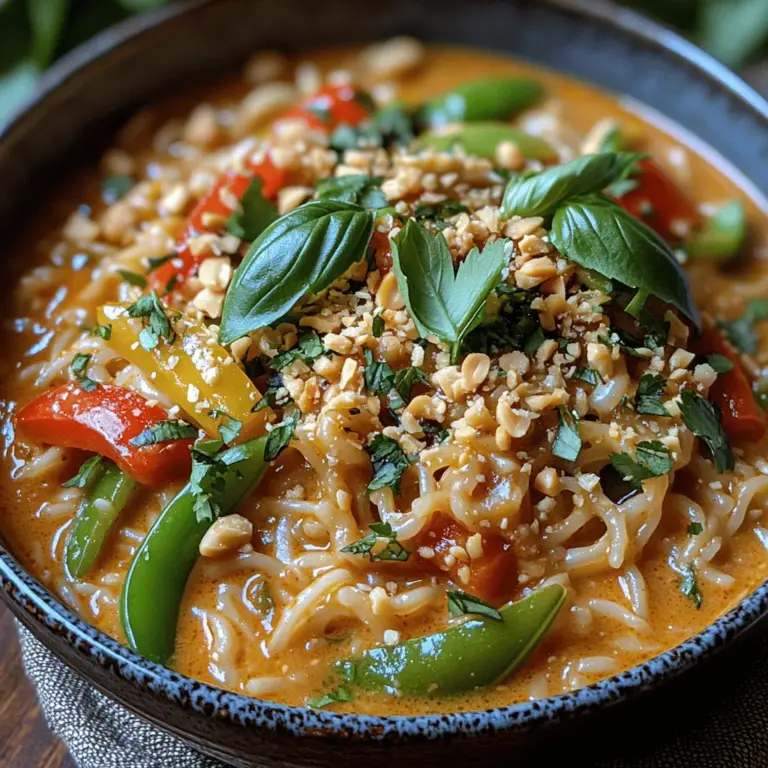Introduction
Thai cuisine is renowned for its vibrant flavors, incorporating a perfect balance of sweet, savory, spicy, and sour elements. From the bustling street food of Bangkok to the sophisticated tastes of fine dining, each dish tells a story rooted in tradition and cultural heritage. One standout dish that captures the essence of Thai cooking is Spicy Thai Coconut Curry Noodles. This dish is a harmonious blend of rich coconut milk, aromatic herbs, and a kick of spice that transports your taste buds straight to Southeast Asia.
At the heart of this culinary delight are two key ingredients: coconut milk and curry paste. Coconut milk, extracted from the flesh of fresh coconuts, adds a creamy texture and subtle sweetness, perfect for balancing the heat of the curry paste. Speaking of curry paste, this essential component is a blend of various spices and herbs that infuse the noodles with depth and complexity. Together, they create a dish that is not only comforting but also bursting with flavor.
In this article, we will explore the essential ingredients that make up Spicy Thai Coconut Curry Noodles, delve into the cooking techniques required to perfect this dish, and guide you through crafting a delicious coconut curry sauce. Whether you are a seasoned chef or a novice in the kitchen, this recipe offers a delightful way to experience the flavors of Thailand in your own home.
Understanding the Ingredients
Creating the perfect bowl of Spicy Thai Coconut Curry Noodles begins with selecting high-quality ingredients. Let’s take a closer look at the key components that contribute to this dish’s unique flavor profile.
Rice Noodles: Options and Substitutes
Rice noodles are the foundation of this dish, providing a light and chewy texture that pairs beautifully with the rich curry sauce. You can find various types of rice noodles, including flat, wide noodles (often used in Pad Thai) and thinner vermicelli noodles. For this recipe, medium-width rice noodles are ideal as they absorb the flavors of the sauce while remaining tender without becoming mushy.
If you’re looking for alternatives due to dietary restrictions, consider using gluten-free options such as quinoa noodles or even spiralized vegetables for a low-carb version. Each alternative will offer a unique texture and taste, allowing you to customize the dish to your preference.
Coconut Oil: Benefits and Flavor Profile
Coconut oil is another essential ingredient in this dish, used for sautéing the aromatics and adding an extra layer of coconut flavor. Unlike other oils, coconut oil has a high smoke point, making it perfect for stir-frying. Additionally, it is rich in medium-chain triglycerides (MCTs), which are known for their health benefits, including improved metabolism and energy levels.
Using coconut oil not only enhances the flavor of the noodles but also contributes to the overall creaminess of the dish, complementing the coconut milk perfectly. If coconut oil is unavailable, you can substitute it with vegetable oil or avocado oil, though the distinct coconut flavor will be missed.
Fresh Aromatics: The Role of Onion, Garlic, and Ginger
No Thai curry is complete without the aromatic trio of onion, garlic, and ginger, which form the flavor base for this dish. Onions add sweetness and depth, while garlic contributes a pungent, savory note. Ginger, with its warm and spicy flavor, adds a refreshing kick that enhances the overall complexity of the dish.
When preparing these aromatics, it’s essential to chop them finely to ensure they sauté evenly and release their flavors effectively. Sautéing them in coconut oil until fragrant will lay the foundation for a robust and savory curry sauce.
Vegetables: Nutritional Benefits of Bell Peppers and Snow Peas
Colorful vegetables not only add visual appeal to your dish but also provide essential nutrients. For this recipe, bell peppers and snow peas are excellent choices. Bell peppers come in various colors—red, yellow, and green—each offering a slightly different flavor profile and a rich source of vitamins A and C.
Snow peas, on the other hand, are crisp and sweet, adding a delightful crunch to the dish. They are also low in calories and high in fiber, making them a nutritious addition. You can easily customize the vegetable selection based on your preferences or seasonal availability, incorporating carrots, zucchini, or bok choy for additional variety.
Coconut Milk: Creaminess and Its Significance in Curries
Coconut milk is arguably the star ingredient of this recipe. It adds a luscious creaminess that balances the spiciness of the curry paste while providing a slightly sweet undertone. When shopping for coconut milk, look for full-fat varieties for the richest flavor and texture. Light coconut milk can be used as a healthier alternative, but it may not yield the same creaminess.
In addition to flavor, coconut milk is also packed with nutrients, including vitamins C, E, and B vitamins, as well as minerals like magnesium and potassium. This makes it not just a delicious choice but a wholesome one as well.
Red Curry Paste: A Closer Look at Its Composition and Heat Levels
Red curry paste is the heart of this dish, providing the characteristic heat and depth of flavor that defines Thai curries. Typically made from red chilies, lemongrass, galangal, kaffir lime leaves, and shrimp paste, this spice blend can vary significantly in heat levels depending on the brand and recipe used.
When choosing red curry paste, consider your heat tolerance and the specific flavor notes you desire. For a milder version, look for paste labeled as “mild” or “medium.” Alternatively, you can make your own at home by blending fresh ingredients or adjust the amount used in the recipe to suit your taste.
Soy Sauce and Brown Sugar: Balancing Flavors in the Dish
To bring all the flavors together, soy sauce and brown sugar are added to the curry sauce. Soy sauce provides umami and saltiness, while brown sugar adds a hint of sweetness that rounds out the dish. This combination creates a harmonious balance, ensuring that no single flavor overpowers the others.
For those with dietary restrictions or preferences, low-sodium soy sauce can be used to reduce sodium intake, while coconut aminos serve as a soy-free alternative. Brown sugar can be replaced with coconut sugar for a more natural sweetener option that complements the coconut theme of the dish.
Cooking Techniques for the Perfect Noodles
To achieve the perfect Spicy Thai Coconut Curry Noodles, mastering the cooking techniques is essential. Here’s a step-by-step guide to ensure your noodles turn out perfectly every time.
Importance of Properly Cooking Rice Noodles
Cooking rice noodles may seem straightforward, but it requires attention to detail to avoid stickiness. Start by bringing a large pot of water to a boil. Once boiling, remove the pot from heat and add the rice noodles. Allow them to soak for 5-8 minutes, or until they are just tender but still firm to the bite (al dente).
It’s crucial not to overcook the noodles, as they will continue to cook when tossed in the hot curry sauce. After soaking, drain the noodles and rinse them under cold water to stop the cooking process and remove excess starch. This step is essential for preventing the noodles from clumping together.
Alternative Noodle Options for Dietary Preferences
If you have specific dietary preferences, several alternatives can be used in place of traditional rice noodles. For a gluten-free option, consider using rice vermicelli or even zucchini noodles (zoodles) for a lighter, low-carb dish. Quinoa noodles are another excellent choice, providing a protein boost and a unique flavor.
Each alternative will change the texture and taste of the dish slightly, so feel free to experiment and find the combination that suits your palate best.
Techniques for Sautéing Aromatics to Maximize Flavor
Sautéing the aromatics is a crucial step in developing the dish’s flavor. Start by heating coconut oil in a large skillet or wok over medium heat. Once hot, add the chopped onions and sauté for about 2-3 minutes or until they become translucent. Next, add minced garlic and ginger, cooking for an additional 30 seconds until fragrant.
The key to maximizing flavor during this step is to ensure the aromatics do not burn. Stir frequently and adjust the heat as necessary. This technique allows the oils in the aromatics to release their flavors into the oil, creating a rich base for your curry sauce.
Tips for Achieving the Perfect Vegetable Texture
To maintain a delightful crunch in your vegetables while ensuring they are cooked through, it’s essential to add them to the skillet at the right time. After sautéing the aromatics, add your bell peppers and snow peas, stirring frequently for about 3-4 minutes.
The goal is to cook the vegetables until they are slightly tender yet still vibrant and crisp. If using a mix of vegetables, consider adding those that require longer cooking times first, such as carrots, and then gradually add quicker-cooking vegetables to achieve the desired texture.
Crafting the Flavorful Coconut Curry Sauce
Now that we have all the essential ingredients and techniques down, it’s time to craft the rich and flavorful coconut curry sauce that brings this dish together.
In-Depth Explanation of the Sauce-Making Process
Begin by adding the prepared rice noodles to the sautéed aromatics and vegetables in the skillet. Next, pour in the coconut milk and add the red curry paste, soy sauce, and brown sugar. Stir to combine all the ingredients, ensuring that the noodles are well coated with the sauce.
To enhance the flavors, allow the mixture to simmer over low heat for about 5-10 minutes. This simmering process is crucial as it allows the flavors to meld together, creating a rich and harmonious sauce. Stir occasionally to prevent sticking, and adjust the seasoning as needed. You can add extra soy sauce for saltiness or more curry paste for heat, depending on your preference.
Simmering not only intensifies the flavors but also helps the noodles absorb the delicious sauce, resulting in a satisfying and flavorful dish.
With these steps, you’ll be well on your way to creating a vibrant and delicious bowl of Spicy Thai Coconut Curry Noodles. The combination of creamy coconut milk, aromatic spices, and fresh vegetables will leave you craving more, making it a perfect dish for any occasion.


